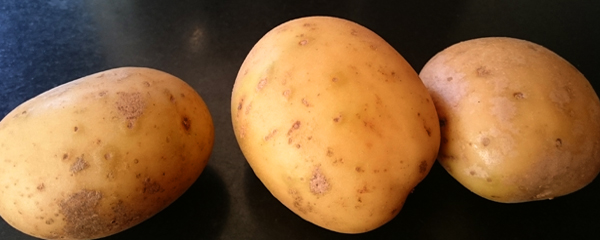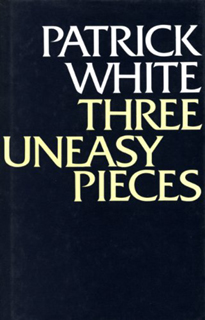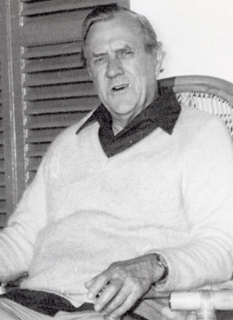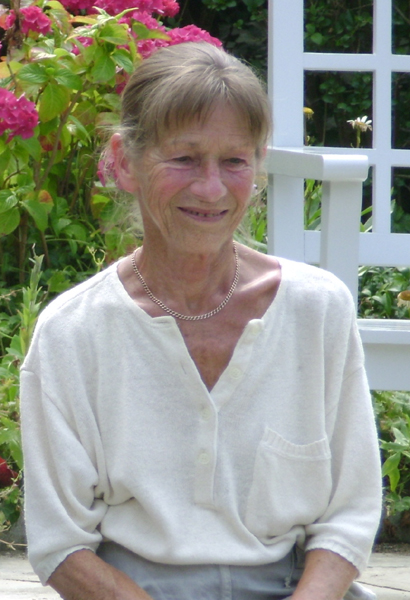
('Spuds' © Whats-Taters, 2017)
THREE UNEASY PIECES
by CHRISTINE GENOVESE
In 1980 I spent six months in South Australia. When I asked friends to recommend an Australian writer, they mentioned Patrick White. White, however, is much more than an Australian writer. To me he’s one of the world’s great writers of magic realism with a touch of mysticism. His writing style is trenchant and studded with surprises, and his plots embrace the cosmic aura of the deathbed in The Eye of the Storm and the oppressive claustrophobia of the Australian desert in Voss.
By 1980 when I read White’s novels, he was already internationally famous. The trigger had been the Nobel Prize for Literature, awarded to him in 1973 for The Eye of the Storm. Before then he’d often been considered too un-Australian down under, while the northern hemisphere tended to dismiss him as irrelevant because he was Australian. An Australian critic described White as ‘Australia’s most unreadable novelist’, while White saw himself as a ‘cosmopolitan Londoner’, or as he – less succinctly – put it in his autobiographical novel Flaws in the Glass, ‘a lapsed Anglican egotist agnostic pantheist occultist existentialist would-be though failed Christian Australian’.
White published three volumes of short stories: The Burnt Ones, The Cockatoos, and Three Uneasy Pieces. He was seventy-five years old in 1987 when he wrote Three Uneasy Pieces, the last publication before his death in 1990. There are obvious auto-biographical elements in these stories, and it’s clear that the first-person protagonist of the three tales is a fictional version of White himself, as he describes feelings of inadequacy – partly those of an old man, and partly those of a flawed life.
On the page usually reserved for the preface there’s a photo of Patrick White and his partner Manoly Lascaris behind the kitchen table, on which three potatoes are laid out. The caption reads: ‘THREE POTATOES, and Two Guest Stars.’
 The stories are each very different in their own right, and yet they form a whole. Three variations on the theme of potatoes? A triptych of three paintings? A musical composition in three parts… perhaps an echo of Stravinsky’s Three Easy Pieces for Piano? But, no, the word ‘uneasy’ is not the antonym of the word ‘easy’ as used by Stravinsky. The unease in these stories is uncomfortable to the point of being sinister and riddled with anxiety, guilt and the fear of death.
The stories are each very different in their own right, and yet they form a whole. Three variations on the theme of potatoes? A triptych of three paintings? A musical composition in three parts… perhaps an echo of Stravinsky’s Three Easy Pieces for Piano? But, no, the word ‘uneasy’ is not the antonym of the word ‘easy’ as used by Stravinsky. The unease in these stories is uncomfortable to the point of being sinister and riddled with anxiety, guilt and the fear of death.
The first ‘potato’ is a very short – and very uneasy – piece called ‘The Screaming Potato’. It’s in the form of a fable. The potato isn’t personified, but it suffers unspeakable pain as its eyes are gouged out when it’s prepared for the pot. The protagonist – I’ll call him PW for convenience – is watching a woman peeling a potato. She hesitates about gouging out the eyes as ‘a certain amount of flesh would disappear with the gouging’. PW asks if becoming a vegan would help. ‘Could we perhaps exist on air till the day we’re returned to earth?’
This little fable is haunting. Both animals and vegetables are tortured so that we can eat. For PW this goes further. We need to ‘atone for the soft cruelties we’ve inflicted on our fellow animals – parents, children, lovers, friends…’
The eyes on the potatoes are their hope of rebirth; maybe of immortality. They’re also a blemish, to be gouged out.
‘Dancing with Both Feet on the Ground’ is the second ‘potato’ in the photo on the preface page. The potato only makes a brief appearance as part of the mess on the kitchen floor from the previous evening. It causes PW to slip and fall while he listens to the radio and starts dancing to the music.
PW starts dancing ‘cautiously’ with both feet on the ground. But ‘inside me, I’m well away’. The dance continues while PW lies helpless on the kitchen floor. The story picks up in a different location, a Swiss Schloss hotel for an idle winter holiday clientele. There’s a new first person protagonist, ‘a pale youth who belongs to no nationality or party’. He moves round the hotel, watching from outside in the snow, or observing through closed doors.
The cameos of guests and their frivolous entertainments are disturbing. They might have been lifted from medieval frescoes, or paintings by Brueghel the Elder and Hieronymus Bosch of the Danse Macabre. The music of Saint-Saëns’ symphonic poem would suit the scenes and the bone-clunking figure of death who leads the dance:
They don’t notice I’m leading them. I am too anaemic, emaciated, outwardly adolescent […] crumbling bones will never prevent me carrying out my duties.
There are lavish descriptions of the decadence of the Schloss hotel:
There are cakes sodden with riches, of rum, chestnut, chocolate cream […] Naked bodies lie mouth to mouth. Stalactites drip from window-frames, expert mouths explore naked breasts all suspended above the darkened valley.
One character stands out: ‘The Contessa del Castelmarino, alias Gladys (Baby) Horsfall of Gundy, New South Wales.’
Gladys, Contessa del Castelmarino, needs a faith to compensate for the decline of her beauty now that her cleavage is getting draughty. She has hired a priest, Agostino, to instruct her, but Agostino is very busy at the hotel. ‘Someone is waiting for confession, instruction, extreme unction. Agostino has even been known to administer an enema.’
White often uses bathos to shock the reader and make sure they don’t settle into a comfortable reading of these stories. They are intentionally ‘uneasy’. When the musicians stop for a pause during Le Thé Dansant, ‘which has failed to dissipate l’ennui’, he writes:
Music expires in a series of wistful whinnies and whimpers. Denied the freedom of the dance, wooden figures trudge across the floor, get back the feel of their hinges, adjust disbelieving papier mâché masks. One sax lets out an uncontrolled fart.
The Danse Macabre episode ends when Baby Horsfall slips on the dance floor and lapses from her precious Contessa-speak into coarse, ‘Strine’ vernacular, ‘Shit, Paddy!’ she blubbers. ‘For Chrissake, I’ve buggered me coccyx!’ She’ll buy freedom from pain as ‘money is no object’. She’ll also buy whatever else is available from the confessor.
Back in the kitchen, PW raises himself up on the edges of stove and bench. ‘Life doesn’t end on the kitchen floor while there is the will to dance.’ In ‘Dancing with Both Feet on the Ground’, dancing is an affirmation of life. Death is a corollary of old age – and of life; PW tries to balance the two. Death is the great equaliser, they say.
PW, and White himself, were born into the privileged classes. White, like his fictional equivalent, never had to make an effort to get what he wanted. Money, status, material goods, education, fame: it was his birth-right and there was no merit in his success. The corollary is the heavy burden of guilt which he explores in the final story.
The third ‘potato’ on the kitchen table is ‘The Age of a Wart’. It’s the longest story of the three, at about thirty-five pages.
The wart in this story harks back to the theme of the eye on the potato. It’s a blemish on the first knuckle of PW’s right hand, and in the course of the story it becomes a symbol of both death and immortality.
In musical terms, this story would be a fugue. In literary terms, it would be a doppelgänger story. The character of Bluey, or Tancred by his real name, is introduced at the beginning of the story when he and PW become friends. Soon after that Bluey simply opts out and leaves school to pursue his own goals. The remainder of the narrative describes PW’s lifelong search for his lost friend during his travels around the world.
PW and Bluey are diametrically opposite in every way… and therefore complementary. Bluey’s mother is a widow who works as a nurse, and they live in a dismal high-rise flat. PW’s mother has a chauffeur-driven Bugatti; they have maids and ormolu furniture. PW’s brogues are hand-made; he has his own special ‘last’ molds. PW is also the star pupil at school.
 He is convinced he caught his wart from Bluey, and he resents the ugly blemish just as he resents everything else about Bluey. The snobbery that underlies his resentment is brilliantly implied – partly as a blemish, partly as inevitable. He reluctantly accepts an invitation to have tea at Bluey’s place after school. While the two boys walk to the flat Bluey grabs his hand, comparing their two warts, ‘and mumbles, “Twins!” as he grinds his wart into mine’. It’s a parody of the blood-brother ceremony and it makes PW uneasy. Nevertheless, the afternoon at Bluey’s flat, where Bluey’s mother serves them a very simple meal, changes their relationship dramatically. PW has a sort of epiphany next to his new friend, and a few days later he instinctively defends Bluey to his headmaster: ‘“Bluey doesn’t need to be a scholar. He’s more…” I gasp “…more of a… a mystic!”’
He is convinced he caught his wart from Bluey, and he resents the ugly blemish just as he resents everything else about Bluey. The snobbery that underlies his resentment is brilliantly implied – partly as a blemish, partly as inevitable. He reluctantly accepts an invitation to have tea at Bluey’s place after school. While the two boys walk to the flat Bluey grabs his hand, comparing their two warts, ‘and mumbles, “Twins!” as he grinds his wart into mine’. It’s a parody of the blood-brother ceremony and it makes PW uneasy. Nevertheless, the afternoon at Bluey’s flat, where Bluey’s mother serves them a very simple meal, changes their relationship dramatically. PW has a sort of epiphany next to his new friend, and a few days later he instinctively defends Bluey to his headmaster: ‘“Bluey doesn’t need to be a scholar. He’s more…” I gasp “…more of a… a mystic!”’
That’s the beginning of PW’s quest for his lost twin, the mystic, saint, redeemer, lover, doppelgänger. There are war-time sightings: “Saw him yesterday down Bethnal way dragging the corpses out from under the rubble.” Or near Hiroshima: “–moistening with a drop of broth the hole which had once been a mouth.” Bluey – now referred to by his real name, Tancred – is always in action, getting his hands dirty, while PW reflects that, ‘To be truthful, I would have preferred to evoke the exquisitely formal Japanese scroll of Hiroshima in its nest of mountains…’ There is self-deprecation in PW’s words, and this feeling intensifies as the fugue accelerates and Tancred remains out of reach.
I make speeches to promote literature and ethics. I accept those frivolous honours, Honorary Degrees. I am turning into a stuffed turkey at banquets I help the establishment eat.
In his dreams PW is united with Tancred, the lover. These scenes are full of surrealistic imagery and syncopated language.
PW’s life is tidy: his ethics are admirable and he has a strong, aesthetic sense of beauty. But his need to find Tancred grows more desperate with age. Of course, his wart disappeared a long time ago – it would jar with his life style – and instead, he has developed different blemishes on his skin; this time they’re melanomas.
In hospital, PW is still hoping to be reunited with Tancred before he dies. Hospital staff reassure him that people recover from melanomas every day. ‘“Not from mine. It’s everybody’s. It’s spreading throughout the world. Darker every minute. You’ve only got to look out the window.”’
The end comes when someone administers ‘the ubiquitous needle’.
And then… then…
He has come. He is holding my hands in his […] As the world darkens, the evil in me is dying. I understand. Along with the prisoners, sufferers, survivors. It is no longer I, it is we.
The Danse Macabre has ended. The doppelgänger has fused with his double. The eye of the potato promises resurrection. The blemish has gone through a whirlwind of transmutations along the road including glimpses of World War Two bombings and Hiroshima. The stories are harrowing, and yet, in spite of White’s negative view of PW, the passive, privileged aesthete, these Three Uneasy Pieces leave a haunting – almost poetic – impression of the individual, and of our world being dragged along in the Dance of Death towards disaster, unless we succeed in our quest for redemption.
~
 Christine Genovese moved to rural Normandy about twenty-five years ago, juggling a teaching career, writing and ‘life generally’. She escaped the isolation of the expat writer by joining a lively and supportive email writing group. Her repertory includes articles and short stories, and she’s reasonably happy with how these have fared in publications and competitions.
Christine Genovese moved to rural Normandy about twenty-five years ago, juggling a teaching career, writing and ‘life generally’. She escaped the isolation of the expat writer by joining a lively and supportive email writing group. Her repertory includes articles and short stories, and she’s reasonably happy with how these have fared in publications and competitions.

